Category: Business Strategies
Posted by Dr. El - April 13, 2018 - Business Strategies, Communication, Customer service, End of life, Engaging with families, McKnight's Long-Term Care News, Resident care, Stress/Crisis management, Transitions in care

Here’s my latest article on McKnight’s Long-Term Care News:

In one of the more disturbing encounters I’ve had in long-term care — in a 5-Star deficiency-free nursing home — I offered my condolences to an aide on the loss of a resident she’d cared for over a period of two years.
The aide, a heavyset woman, smiled as she told me that she’d known the resident was dying and had urged the nurse to send her to the hospital quickly. The reason? She didn’t want to wrap the body of the equally heavyset resident after she died.
The resident died among strangers in an ambulance on the way to the hospital.
While I’d like to think the incident was an anomaly, I suspect many if not most nursing homes lack a mission statement for end-of-life care and that most teams can be better prepared for the last months and days of their residents.
Without leadership and training, disorganization and staff priorities can derail the care philosophy of the facility.
Providing decent end-of-life care is more than determining if a resident is DNR or full code. It includes recognizing that someone may be nearing the end of life, referring him or her to hospice while they’re most able to benefit from it, communicating regularly with the resident and their family about their needs, and treating the dying person, their remains and their belongings with respect.
Impact on families
Incidents such as the one above reflect poorly on the organization, even if family members don’t realize that it could have been averted with proper staff training. We often hear how important it is to make a good first impression, but as community institutions relying on reputation and referrals, it’s also essential to make a good last impression.
I’ve heard family members comment that they hadn’t always been pleased with the care at the home but they felt that their mother’s death had been handled with great respect. They left with a feeling of overall satisfaction.
Other families had been reasonably satisfied all along, but departed from the facility in shocked dismay at the end of their parent’s life at the poor communication, insufficient pain management and casual disregard for the belongings of the deceased.
Resident impact
Residents are closely observing how their neighbors’ deaths are handled because they know that this is how they will be treated when their time comes. Based on my experience, the things they find most disturbing are inadequate pain management, unacknowledged deaths and seeing the belongings of their friends removed in clear plastic garbage bags rather than in labeled boxes. They find it most comforting when they see that patients are referred to hospice, surrounded by loved ones, sleeping calmly through the night and when there’s a discussion of the loss among the residents, staff and chaplaincy.
Staff impact
The ways in which facilities handle deaths can have a big impact on staff members as well. As I suggest in “Absenteeism and turnover? Death anxiety could be the cause,” lack of attention to the experience of staff members in handling loss can contribute to employee turnover.
For the entire article, visit:


Posted by Dr. El - March 28, 2018 - Business Strategies, Communication, Customer service, Engaging with families, McKnight's Long-Term Care News, Resident education/Support groups, Technology, Transitions in care

Here’s my latest article on McKnight’s Long-Term Care News:

At Maimonides Medical Center, 24 frail older adults were taught to use laptops so that they could manage their health information from home. The technology facilitated communication between patients and providers and improved the quality of life of participants.
The program was a collaboration between the Department of Geriatrics at Maimonides and the Older Adults Technology Services (OATS), who trained the elders and installed the laptops in their homes. I met with OATS founder Tom Kamber, Ph.D., to follow up on our conversation earlier this year and to hear more about how technology can play a role in reducing costs and improving the quality of care for nursing home residents.
Kamber was enthusiastic about the Maimonides program, noting that the elders, with an average age of 85, were able to use the devices to manage information, communicate with the care team and explore areas of interest.
Fun, he emphasized, is crucial to success.
The desire to connect with the grands on Facebook is a more powerful motivator to learn new skills than is tracking blood sugar levels.
For facilities, particularly those working in healthcare systems focused on providing care at the lowest cost (i.e. in the community or in skilled nursing rather than in the hospital), the ability to remain virtually connected provides a host of benefits. Patients remain within the network, medical issues can be tracked and health crises can be averted before needing expensive hospitalizations. Tailored health information can be offered effortlessly, such as sending out post-surgery information videos at a scheduled time. Patient and family satisfaction increases, as does that of care providers who can quickly answer questions via email rather than return lengthy phone calls at the end of a long workday.
From a mental health standpoint, the program is a winner. Residents and their families are typically anxious about discharge and how to manage once they’re home. A virtual system reduces anxiety because it allows for easy access to medical professionals, offers continuity of care and averts costly, stressful and frequently debilitating hospitalizations.
For the entire article, visit:

Tom Kamber,PhD
Executive Director, OATS
Older Adults Technology Services
Posted by Dr. El - March 19, 2018 - Books/media of note, Business Strategies, McKnight's Long-Term Care News

Here’s my latest article on McKnight’s Long-Term Care News:

Three new books on aging and healthcare recently crossed my desk, each with completely different takes on our industry.
One focuses on ways in which companies, including long-term care organizations, can save on healthcare costs. In another, the author’s insights into elder wisdom can be used by facilities to add to the quality of life of residents. The final book offers an outsider’s view into how our field is perceived by older adults and their families.
Cost savings
In “Health-Wealth: 9 Steps to Financial Recovery,” author Josh Luke, Ph.D., a former hospital CEO turned “healthcare futurist,” argues that our healthcare delivery system is so badly broken that we should seek a new model for the healthcare needs of employees.
He outlines a method to implement a consumer-driven model that improves pricing transparency and control over costs. Some of the suggestions are likely to both reduce expenses and increase employee satisfaction. For example, an organization-wide emphasis on health and wellness can be a popular program with medical savings.
Other ideas, such as charging the employee a percentage of care costs over their maximum deductible, won’t be universally appealing but could influence workers to choose more affordable “centers of value” during a health crisis.
If organizations find creative ways to reduce healthcare expenditures for their employees, the market is bound to shift in unexpected directions — and that’s exactly what “industry disruptor” Josh Luke is hoping for.
Quality of life
The second book, “The End of Old Age” by Marc Agronin, M.D., offers a hopeful view of aging that will resonate with those in the field.
I was particularly struck by the fact that Agronin, a geriatric psychiatrist, began his book with a chapter on why we should grow old, addressing issues around end of life choices and the way we approach old age. The foundation of acknowledging that some people don’t actually want to live to old age is a crucial exploration that sets the tone for the rest of the book.
Subsequent chapters point to the value of aging in very specific ways. While older adults may not surpass younger people at tasks that require speed or visual acuity, for example, Agronin details five different forms of wisdom in which elders excel. The book includes tools so that others, such as families and staff members, can use his model to help elders make use of their strengths and recognize their purpose at this phase of life.
For the entire article, visit:



Posted by Dr. El - March 9, 2018 - Books/media of note, Business Strategies, McKnight's Long-Term Care News

McKnight’s Online Expo, FREE, March 14th and 15th 2018
Earn 5 Free CEUs at 5 Free webinars

Once again, McKnight’s will host its annual online expo, which is a chance to attend a conference without leaving your desk. Register for the conference in advance, and then log in to hear the talks, visit the vendors, and chat with the reps and attendees.
This year’s topics are:
PAYMENT: Operational strategies for surviving regulatory, payment and database changes
WOUND CARE: Is the Braden Scale increasing your facility’s risk of malpractice?
TECHNOLOGY: Telehealth and Reimbursement: What you need to know for the near term
QUALITY: Beyond a fire drill: Emergency prep steps for active shooters in your building
CAPITAL: The new funding sources
Posted by Dr. El - March 3, 2018 - Business Strategies, Communication, McKnight's Long-Term Care News, Motivating staff

Here’s my latest article on McKnight’s Long-Term Care News:

When we think of teamwork in long-term care, we envision a group of dedicated specialists working together to provide the best care for our residents. They read notes from other disciplines, bounce ideas off colleagues at the nursing station and convene care plan meetings.
In reality, teamwork in long-term care is much more complex.
Teamwork basics
Team members include not just clinical staff, residents and family members, but other workers who frequently have an influence on care, including housekeepers, laundry workers, maintenance staff and security guards. To enhance teamwork, these employees should be included in in-service trainings that might initially appear beyond their purview, such as customer service training and education about the medical and behavioral information they may need to relay to the nurses.
Teamwork is strengthened when team members understand the work of their colleagues and when it can best be utilized. For example, a lack of understanding of the difference between psychology and psychiatry services can cause delays in the receipt of needed treatment. Consider monthly training lunches that can boost morale, increase interdepartmental understanding and improve team functioning.
Team members also include those outside the facility, such as medical specialists, dialysis centers and hospitals, as well as consultants who provide onsite care such as psychiatrists, dentists, respiratory therapists and others.
Unifying all these team members requires uncomplicated and reliable conversation and correspondence. Communication can be enhanced in a variety of ways, including computerized records that eliminate paper consults and indecipherable handwriting, enhanced change of shift reports that include behavioral as well as physical information and a management commitment to staff retention to create the stability necessary for a solid team.
Taking it further
Once teamwork basics of role understanding, stable staffing and communication are covered, teams can begin to address teamwork at a deeper level.
Deep teamwork involves observing how the floor, unit or neighborhood is functioning as a whole over different shifts.
A team is not functioning well if a disruptive resident is keeping others awake at night or frightened during the day. Nor is it a high functioning team if two staff members are in a personal argument that’s obvious to all who walk onto the floor.
Deep teamwork calls for observing the interactions of the team and intervening as necessary to guide them back on track.
For the entire article, visit:

Posted by Dr. El - February 15, 2018 - Business Strategies, Customer service, Inspiration, McKnight's Long-Term Care News, Resident care, Tips for gifts, visits

Here’s my latest article on McKnight’s Long-Term Care News:

Last week, I attended an accessible design symposium at the Cooper Hewitt Museum in New York City to see what ideas I could use with elders in long-term care. Through listening to the symposium speakers, reading descriptions of works featured in the student design contest and viewing the Access+Ability exhibit, I found more than I had expected.
Crash course in accessible design
I suspect I’m not the only McKnight’s reader with a lack of knowledge about accessible design — even though we work with elders with abilities that are typically different than those of younger adults.
Patricia Moore, introduced as “the mother of universal design,” told the audience that her elderly grandparents inspired her work. They struggled to maintain their independence in a world that made it difficult for them. “Grandma wasn’t broken,” she said. “The tools we gave her were inadequate.”
In my crash course in accessibility, I learned that objects can be designed in ways that increase the mismatch between our bodies and the environment or, in accessible design, to intentionally decrease that mismatch. For example, the standard design of a walking cane allows it to fall to the floor, making it difficult to retrieve for someone with mobility problems. In the Cooper Hewitt exhibit, I saw canes that stayed upright when not in use.
Another speaker discussed how “designing for disability” very often results in products that are good for everyone, such as books on tape, height adjustable desks or ramps for building access that are used by parents pushing strollers and travelers with rolling suitcases, in addition to those with walkers or wheelchairs.
Nothing about us without us
There was a small, vocal group of disability activists present. When I entered the symposium I was handed a card from their organization that read, “Nothing about us … without us.” They echoed the sentiment of the speakers that increasing the diversity of people designing products and systems results in products and systems that work better for a larger number of people.
Including elders and direct care staff in more of the decisions that affect them within our organizations is likely to result in better decisions.
For the entire article, visit:

Jeweled Hearing Aids

Posted by Dr. El - January 31, 2018 - Business Strategies, McKnight's Long-Term Care News, Resident education/Support groups, Transitions in care

Here’s my latest article on McKnight’s Long-Term Care News:

Amy Gotwals, the Chief of Public Policy and External Affairs at the National Association of Area Agencies on Aging, kicked off the 28th Annual Aging Conference in New York City last week, held at the New York Academy of Medicine and filled with attendees providing community-based care for elders. Her rousing keynote outlined the vast care demands of the growing wave of elders and the importance of building healthcare partnerships.
Some of Gotwals’ statistics were startling despite knowledge of the impending “silver tsunami.” Some areas of the country are projected to see an increase in Alzheimer’s diagnoses of 50% to 80% by 2025. Family caregivers between 65 and 74 years old provide more than 30 hours of care per week; for those 75 and older, it’s more than 34 hours each week.
Statistics such as these point to ways in which long-term care organizations can position themselves to be relevant far into the future by offering, for instance, memory or respite care.
Gotwals reported that local Area Agencies on Aging (AAAs), of which there are 622 across the country, are increasingly contracting with healthcare organizations to provide services such as care transitions, nutritional services, home evaluations and evidence-based self-management for chronic diseases.
In one example, San Francisco’s Institute on Aging (IOA) partnered with a nonprofit, community-based housing agency and contracted with the Health Plan of San Mateo County to provide care management services that reduced monthly spending per member by nearly 50%.
While local organizations may not be as seasoned in business promotion, they’re experts in the needs of the local community and their established presence in the neighborhood can be a boon to long-term care organizations seeking to create new partnerships.
ElderTech
After hearing Gotwals’ opening remarks, I chose a breakout session on technology and design presented by Tom Kamber, Ph.D., founder and director of Older Adults Technology Services (OATS). His is a national organization that provides technology-based senior centers and collaborates with a wide range of institutions to address the tech needs of elders.

Posted by Dr. El - January 4, 2018 - Business Strategies, Communication, McKnight's Long-Term Care News, Motivating staff

Here’s my latest article on McKnight’s Long-Term Care News:

Ahhh. A new year. It’s time for a fresh start, the chance to take life in a different direction.
Many of my friends have remarked to me that they want more focus on family and friends this year. They’d like to achieve a better balance between work and home.
On the job in long-term care, perhaps the goal is to tackle the staff turnover problem or increase profitability. Or maybe the hope is that resident, staff and family satisfaction ratings will be better in 2018 or that this might be the year to achieve a five-star rating.
The common thread between these goals is deepening the attention paid to the people in our personal and business lives.
When staff members don’t feel valued, or inspired by the mission of the company, turnover increases, making it virtually impossible to have high satisfaction scores and five-star ratings. Repeatedly recruiting and training new staff cuts into profit margins and damages worker morale.
To turn things around in one’s personal life, conscious decisions can be made around limiting time on electronics or choosing to fill the new calendar year with events that connect loved ones. At work, changes can occur by prioritizing the way staff members are treated and revamping the culture of the company, altering the way people interact.
Whatever our roles in LTC, there are steps each of us can take to enhance the way we treat each other and to have a positive impact on workplace culture.
• Reevaluate mission and culture. Readers in a position to revise the organizational customs as a whole might enlist experienced guides in the process. A consulting and coaching company such as Drive, with which I’m affiliated, evaluates the strengths and weaknesses of a healthcare organization and provides ongoing support to meet goals throughout the culture change process. As a Drive team member notes in this article onCreating and Sustaining a Strong Culture, follow-through is essential. A consulting team can ensure that bumps in the road don’t become dead ends.
• Investigate known culture change programs. Thankfully, there are many people in our field who have undertaken the daunting task of creating a more gratifying long-term care environment while still following regulations. The new year is an excellent time to take a class with the Pioneer Network or the Eden Alternative, or to learn more about The Green House Model at their 1/9 webinar.
• Promote kindness. If your job in long-term care doesn’t allow you the opportunity to change the overall organizational framework, you can still be an important influence on others with whom you interact by focusing on kindness.

Posted by Dr. El - November 22, 2017 - Business Strategies, Customer service, McKnight's Long-Term Care News, Motivating staff, Resident care, Something Good About Nursing Homes
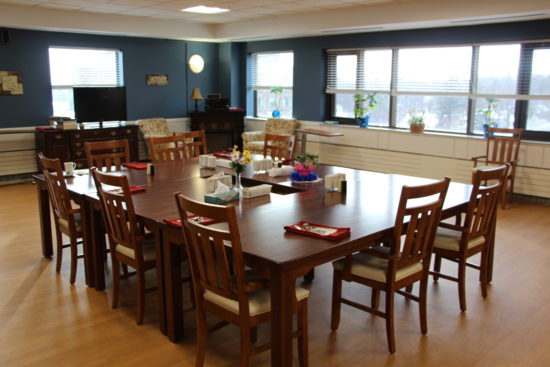
Here’s my latest article on McKnight’s Long-Term Care News:

In 2014, I wrote, “I finally visit a Green House (and it blows my mind).” The Green House is designed with a spacious common area, private bedrooms and showers, unobtrusive medical items and universal workers practicing person-centered care. The model shows that it’s possible to make dramatic lifestyle improvements in long-term care.
It seemed that Green Houses were the answer, if only there weren’t so many traditional facilities already in place. Traditional nursing homes can participate in culture change programs with great success if their leadership is committed to the philosophy through the transition period and beyond. They can retrain staff, add plants and pets and remove nursing stations, but the standard long hallways have remained – until now.
Last week I had the opportunity to speak with Rebecca Priest, LNHA, LMSW, Vice President of Skilled Services, at St. John’s Home in Rochester, NY. She’s presiding over one of the most exciting changes in LTC to come down the pike since, well, Green Houses.
St. John’s is taking a conventional nursing home built in the 1960’s with 32 beds to a hall and turning it into 22 small homes modeled after the Green House Project. Each floor is being systematically transformed into homelike environments with a large space for cooking, dining and socializing and universal workers called “Shahbazim” who are central to the model’s success.
Rather than having aides, housekeepers and laundry workers, the Shahbazim do it all. “The Shahbaz role,” Priest says, “is highly skilled and not for everyone. Shahbazim need to collaborate and be part of a highly sophisticated work team.”
Cross-training staff and flattening the work hierarchy reduces the likelihood that workers will find themselves in “systematically disempowered situations where they are set up to fail.” As a resident I knew used to say, “Amen to that!”
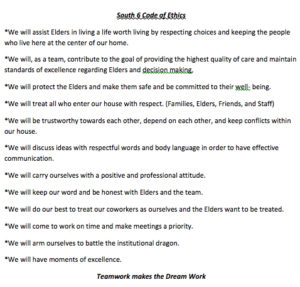
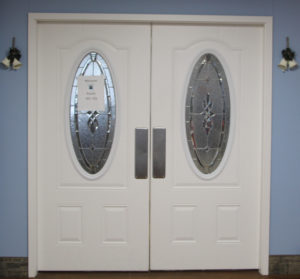
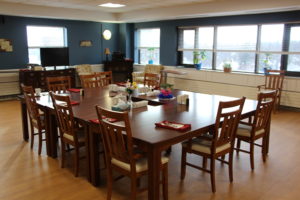

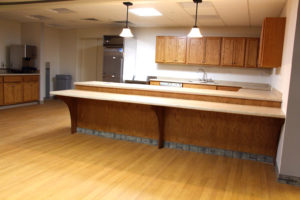
Posted by Dr. El - November 9, 2017 - Business Strategies, Communication, McKnight's Long-Term Care News, Resident education/Support groups, Transitions in care

Here’s my latest article on McKnight’s Long-Term Care News:

Ideas from an interview with Dr. Donna Corrado, Commissioner of the New York City Department for the Aging
Within long-term care, overcoming the problems caused by silos can lead to better care coordination, increased interdepartmental cooperation and reduced work redundancy.
My 1-on-1 interview with Donna Corrado, PhD, Commissioner of the New York City Department for the Aging, suggests there are also benefits to breaking down silos between public and private aging services.
Area Agencies on Aging (AAA)
There are 622 area groups in the National Association Area Agencies on Aging (n4a). According to its website, “the primary mission [of n4a] is to build the capacity of our members so they can help older adults and people with disabilities live with dignity and choices in their homes and communities for as long as possible.”
While n4a’s mission might seem diametrically opposed to the business interests of long-term care, this isn’t the case in a capitated model. When an organization offers a continuum of care with the goal of maintaining people outside of the hospital and at the least expensive level of care, then private and government (and personal) interests align.
My conversation with Dr. Corrado revealed ways of making the most of this alignment of interests, as well as ways to boost the census in long-term care.
AAA offerings
While NYC is the largest Area Agency on Aging in the country, each AAA has it’s own assortment of programs directed toward the needs of their community. There are core issues common everywhere.
Food insecurity is addressed through congregate meals in senior centers and through organizations like Citymeals on Wheels, which provides 8 million meals to New Yorkers Monday through Friday. At the National Readmission Prevention conference I wrote about last month, the speaker from Abbott Nutrition reported that proper nutrition resulted in a 28% decline in hospital readmissions over a six-month period.
Every community has a case management program that assesses individuals and offers home care services.
Senior centers (NYC has 270 of them!) can reduce the epidemic of loneliness and help identify health problems before they become medical emergencies. Funding for senior centers varies greatly, creating opportunities for collaboration.
For the entire article, visit:































